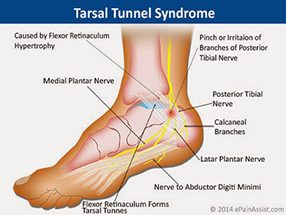
Tarsal tunnel syndrome is a nerve compression disorder in the ankle. You may be familiar with carpal tunnel syndrome in the wrist, it’s similar to tarsal tunnel syndrome. The tarsal tunnel is a pathway for tendons, nerves, arteries, and veins to enter the foot. The structure originates in the leg and makes a turn at the level of the ankle to enter the foot. If you feel the bone on the inside of the ankle and bring your fingers just behind that bone you are at the tarsal tunnel. Each structure: the tendons, nerve, artery, and veins are in different compartments. Essentially, the nerve in the tunnel gets compressed. When there is compression or pressure against the nerve in its compartment it causes burning, shooting, stabbing, and painful problems that extend upwards into the leg or travel down into the foot along the nerve pathway. Causes of tarsal tunnel syndrome can include varicose veins, tendinitis, soft tissue adhesions and narrowed openings for the nerve to traverse, trauma, abnormal stresses from a foot or ankle disorder, to name a few. It’s important to differentiate tarsal tunnel from plantar fasciitis.
The nerve located in the tarsal canal is called the posterior tibial nerve( PTN). Towards the end of the tunnel the PTN branches and divides. The various branches innervate various structures on the bottom of the foot such as muscles and the skin. These branches may also get compressed and cause nerve pain, caused Baxter’s neuritis. Although TTS is the most common, other nerves can become compressed with similar treatment options. These nerves include the common peroneal nerve, superficial peroneal nerve, anterior tibial nerve. Our doctors authored an article in Podiatry today explaining the Keys to detecting and treating entrapment neuropathies

Treatments for TTS include conservative and surgical care. First, it is important to identify why the pain is present. For example, if the syndrome is caused by tendinitis, we will first treat the tendinitis and the TTS will subside. Oral medication, CBD oil (medical marijuana), and physical therapy are all conservative options. If this does not resolve the problem, surgical care includes relieving the compression through a nerve decompression procedure. It is imperative that all of the nerves in the tarsal tunnel and in the foot are released and freed from their surrounding tissue. The post-procedure recovery is quite quick with early weight-bearing and therapy. Patients typically have a resolution of symptoms within three weeks and return to activity within four to six weeks.
